An Engineering Case History of the Prevention and Remediation of Sinkholes Induced by Limestone Quarrying
Abstract
:1. Introduction
2. Research Background
3. Karst Groundwater-Air Pressure Monitoring
4. Design of Grouting Curtain
4.1. Location of the Curtain
4.2. Grouting Borehole Parameters
- (1)
- When the grouting pressure increased uniformly and continuously reaching the designed final pressure, and the slurry suction of the borehole was less than 10 L/min, grouting was conducted for 20–30 min.
- (2)
- After grouting, the Lugeon test was carried out, and the unit permeability was less than 3 lu.
4.3. Implementation of the Data Statistics of the Grouting Curtain
5. Evaluation of the Grouting Effect of the Curtain
5.1. High-Density Resistivity Method
5.2. Verification Boreholes
5.3. Lugeon Test
5.4. Groundwater-Air Pressure Monitoring on Both Sides of the Curtain
- (1)
- The groundwater level on both sides of the curtain were obviously different before and after grouting, and the groundwater level on the north side of the curtain was significantly higher than that on the south side. After the curtain grouting was completed, the groundwater level of borehole SK1 rose by 4.2 m, while boreholes SK2 and SK3 rose by 11.2 m and 11.9 m, respectively. The groundwater level difference on both sides of the curtain increased from 8.0 m to 14.9 m.
- (2)
- The response of the groundwater level on both sides of the curtain to the drilling construction was obviously different. In October 2019, the borehole SK4 drilling construction on the south side of the curtain had a great impact on groundwater; the groundwater level of the adjacent monitoring borehole SK1rose and fell sharply, with a maximum variation of 5.3 m, while the groundwater level at the north side of the curtain was nor disturbed.
- (3)
- The response of groundwater level on both sides of the curtain to rainfall were obviously different. After being recharged by rainfall infiltration, the recharge range on the north side of the curtain was large, and the groundwater level had risen, while the groundwater level on the south side of the curtain has slowly decreased due to the drainage of the quarry.
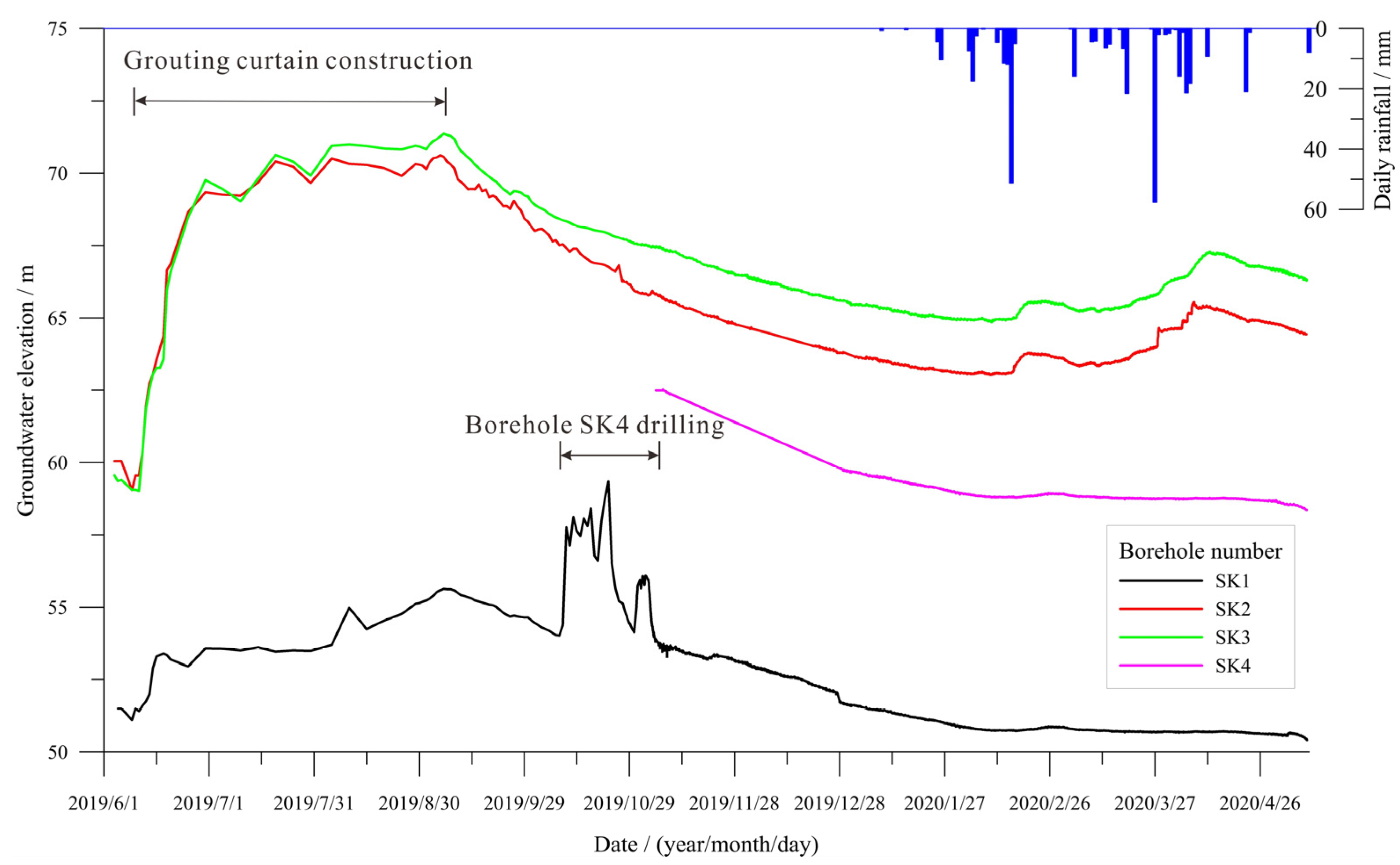
5.5. Water Plugging Effect at Inflow Points
6. Discussions
7. Conclusions
- (1)
- Groundwater-air pressure monitoring is an effective method for monitoring sinkhole hazards, and can capture the abnormal groundwater-air pressure fluctuations before and during the process of sinkhole formation. The abnormal values of groundwater-air pressure fluctuation velocity can reach tens of times the normal fluctuation values, which can be used as a monitoring index for the monitoring and early warning of sinkhole formation.
- (2)
- Grouting curtains are an effective means of controlling water inflow in quarries, as they can effectively control the hazards posed by water flowing through fractures during the quarrying process and greatly reduce damage to the surrounding geological environment. After the curtain construction was completed, the grouting effect was checked by the variation of the curve shape of the high-density resistivity method physical property parameters before and after grouting, and the permeability of the curtain could be verified by combining the results of verification boreholes and Lugeon test.
- (3)
- The evaluation results show that the curtain cut off the groundwater runoff channel and changed the groundwater recharge conditions on both sides of the curtain, resulting in different dynamic changes in the groundwater level on both sides of the curtain; a significant water level difference formed on both sides of the curtain, and the inflow rate reduced from 3500 m3/day to approximately 500 m3/day. However, groundwater will penetrate the karst environment and widen the existing flow paths and create new ones. It is recommended to strengthen groundwater monitoring and make remediation measures based on monitoring results.
Author Contributions
Funding
Institutional Review Board Statement
Informed Consent Statement
Data Availability Statement
Conflicts of Interest
References
- Kastning, E.H. Quarrying in Karst: Geotechnical estimation of environmental risk. In Sinkholes and the Engineering and Environmental Impacts of Karst; American Society of Civil Engineers: Reston, VA, USA, 2008; pp. 704–713. [Google Scholar]
- Pan, Z.Y.; Jiang, X.Z.; Lei, M.T.; Guan, Z.D.; Gao, Y.L. Mechanism of sinkhole formation during groundwater-level recovery in karst mining area, Dachengqiao, Hunan province, China. Environ. Earth Sci. 2018, 77, 799.1–79910. [Google Scholar] [CrossRef]
- Wang, H.; Li, L.; Li, J.P.; Sun, D.A. Drained expansion responses of a cylindrical cavity under biaxial in-situ stresses: Numerical investigation with implementation of anisotropic S-CLAY1 model. Can. Geotech. J. 2022, 60, 198–212. [Google Scholar] [CrossRef]
- Foose, R.M. Ground-water behavior in the Hershey Valley, Pennsylvania. Geol. Soc. Am. Bull. 1953, 64, 623–645. [Google Scholar] [CrossRef]
- Kath, R.L.; Mcclean, A.T.; Sullivan, W.R.; Humphries, R.W. Engineering impacts of karst: Three engineering case studies in Cambrian and Ordovician carbonates of the Valley and Ridge Province. Int. J. Rock Mech. Min. Sci. Geomech. Abstr. 1996, 33, 85A. [Google Scholar]
- Luo, R.; Zheng, X.Z.; Yi, S.M. Current situation and prevention of karst surface-collapse geological disaster in Guangzhou Huadu district. Chin. J. Geol. Hazard Control. 2012, 23, 72–75. [Google Scholar]
- Li, T.Y. The Research on the Karstic Water Control of Depression Pits. Ph.D. Thesis, Guangxi University, Nanning, China, 2016. [Google Scholar]
- Arjwech, R.; Ruansorn, T.; Schulmeister, M.; Everett, M.E.; Thitimakorn, T.; Pondthai, P.; Somchat, K. Protection of electricity transmission infrastructure from sinkhole hazard based on electrical resistivity tomography. Eng. Geol. 2021, 293, 106318. [Google Scholar] [CrossRef]
- Burston, M.R.; Memon, B.A.; Green, D.S. Reducing Conduit Water Flow into a Quarry in North-Central Alabama: A Case Study. In Sinkholes and the Engineering and Environmental Impacts of Karst; American Society of Civil Engineers: Reston, VA, USA, 2008; pp. 640–647. [Google Scholar]
- Han, W.W.; Li, S.C.; Zhang, Q.S.; Zhang, X.; Liu, R.T.; Zhang, W.J.e. A comprehensive analysis method for searching weak zones of grouting curtain in mines. Chin. J. Rock Mech. Eng. 2013, 32, 512–519. [Google Scholar]
- Gao, X.T. High Impermeability Composite Curtain Grouting Scheme and Permeability Detection Method. Mod. Min. 2020, 36, 223–225. [Google Scholar]
- Wang, J. A New Technology of Groundwater Flow Cut off by Grout Curtain for Karst Mineral Deposit. Min. Res. Dev. S 2006, 1, 151–153. [Google Scholar]
- Yang, Q.; Gao, G.F.; Han, G.L.; Yao, H.M. Study on Construction Technology of Mine Curtain Grouting for Cave Formation. Explor. Eng. (Rock Soil Drill. Tunn.) 2010, 37, 67–69. [Google Scholar]
- Sun, K.G.; Li, S.C.; Xu, W.P.; Gong, L. On Grouting Techniques for Preventing Water Inflows in Karst Tunnels. Mod. Tunn. Technol. 2015, 52, 178–183. [Google Scholar]
- Yang, Z.; Zhao, Q.; Huang, B.R. Grouting Control Technology and Engineering Application of Strong Dynamic Channel of Mine Curtain. Min. Res. Dev. 2020, 40, 117–121. [Google Scholar]
- Shao, W.; Sun, Q.X.; Xu, X.; Yue, W.H.; Shi, D.D. Durability life prediction and horizontal bearing characteristics of CFRP composite piles in marine environments. Constr. Build. Mater. 2023, 367, 130116. [Google Scholar] [CrossRef]
- Wei, H.M.; Li, X.; Sun, B.T.; Zhou, S.; Niu, J. Exploration and analysis of geophysical methods in curtain grouting water control. Geophys. Geochem. Explor. 2021, 45, 245–251. [Google Scholar]
- Jiang, X.Z.; Lei, M.T. Monitoring technique and its application of karst groundwater-air pressure in karst collapse. Carsologica Sin. 2018, 37, 786–791. [Google Scholar]
- Dong, H.B.; Wang, C.L. Development and application of 2D resistivity imaging surveys. Earth Sci. Front. 2003, 10, 171–176. [Google Scholar]
- Ezersky, M.G.; Eppelbaum, L.V.; Al-Zoubi, A.; Keydar, S.; Abueladas, A.; Akkawi, E.; Medvedev, B. Geophysical prediction and following development sinkholes in two Dead Sea areas, Israel and Jordan. Environ. Earth Sci. 2013, 70, 1463–1478. [Google Scholar] [CrossRef]
- Satitpittakul, A.; Vachiratienchai, C.; Siripunvaraporn, W. Factors influencing cavity detection in Karst terrain on two-dimensional (2-D) direct current (DC) resistivity survey: A case study from the western part of Thailand. Eng. Geol. 2013, 152, 162–171. [Google Scholar] [CrossRef]
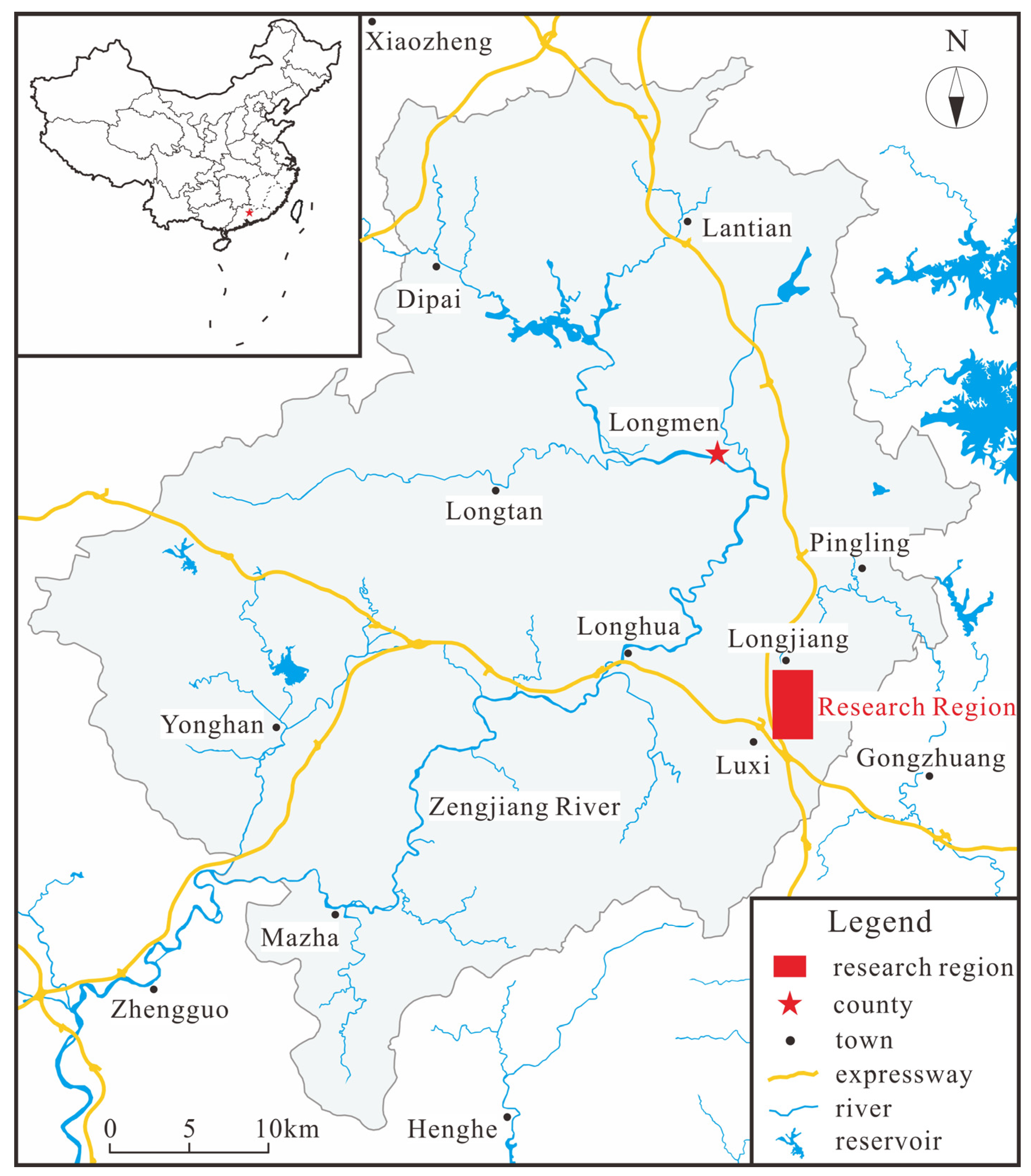
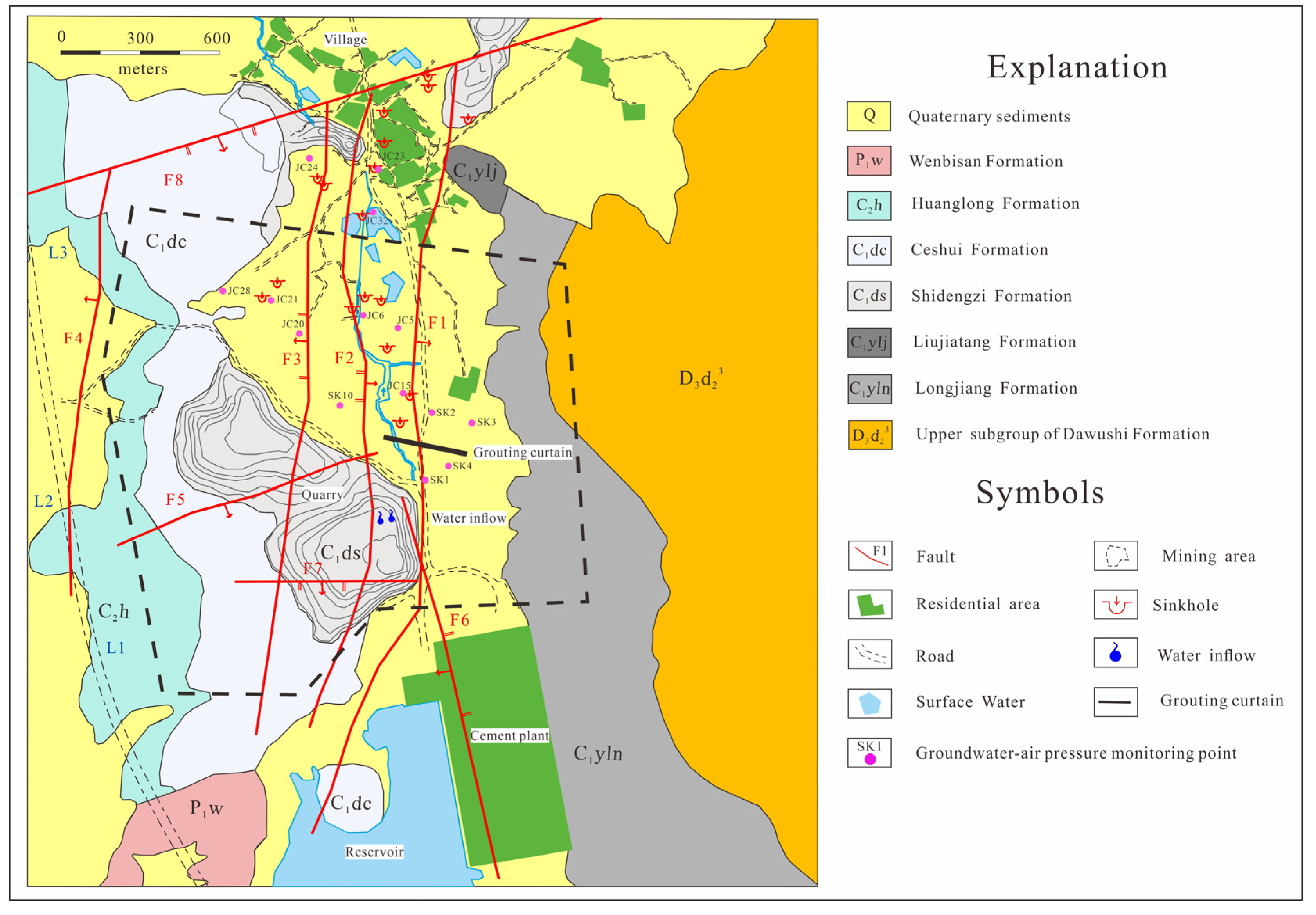
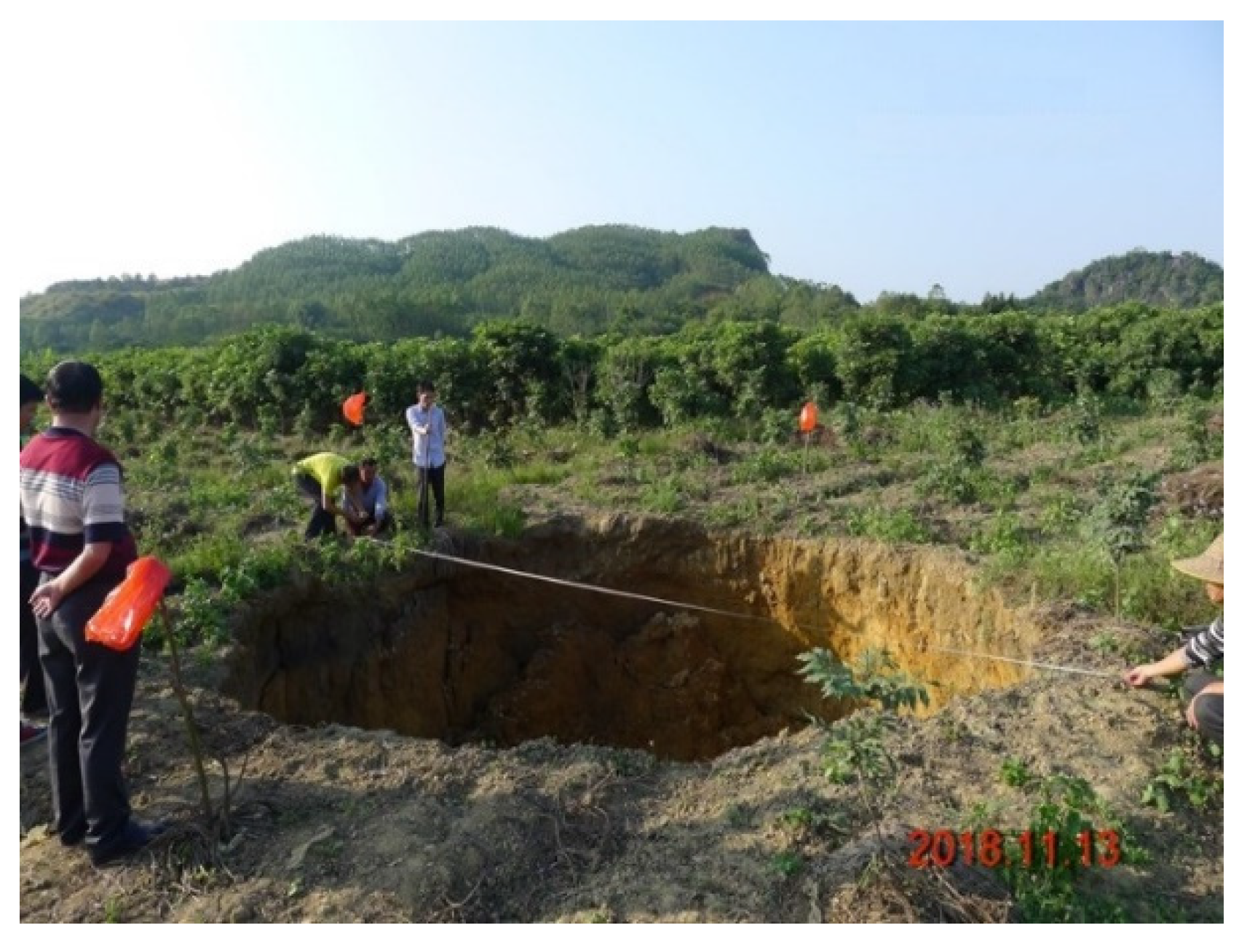
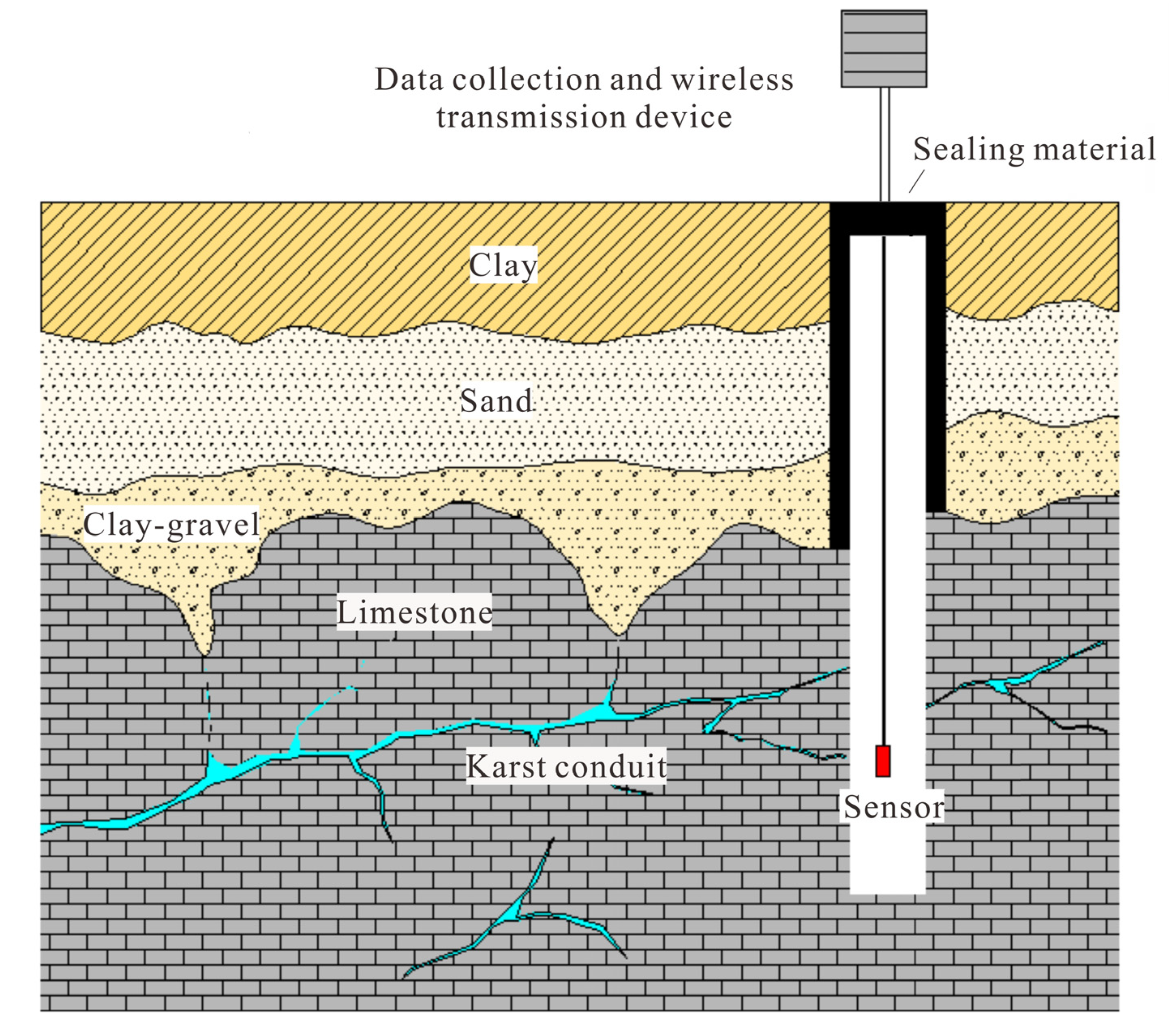



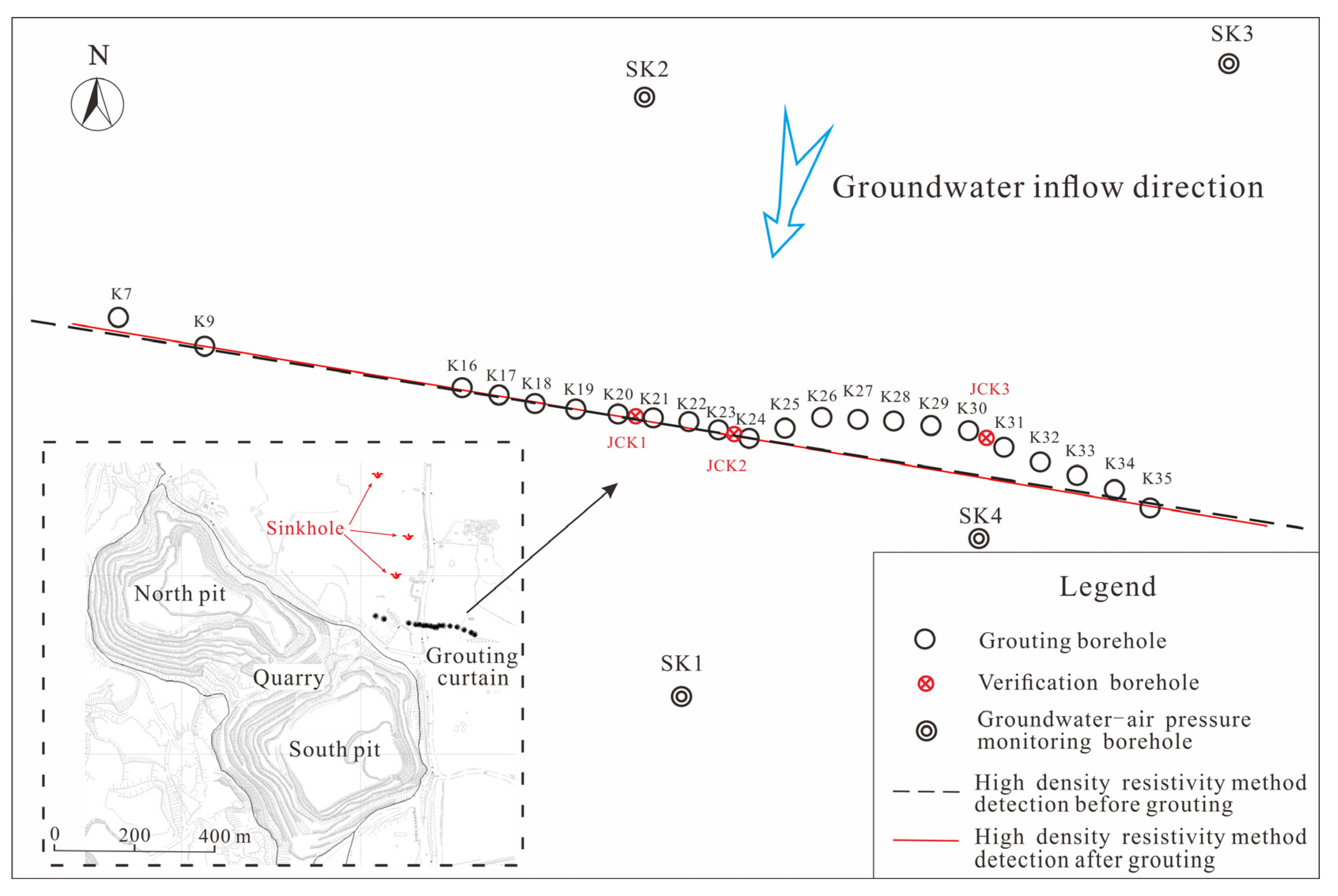



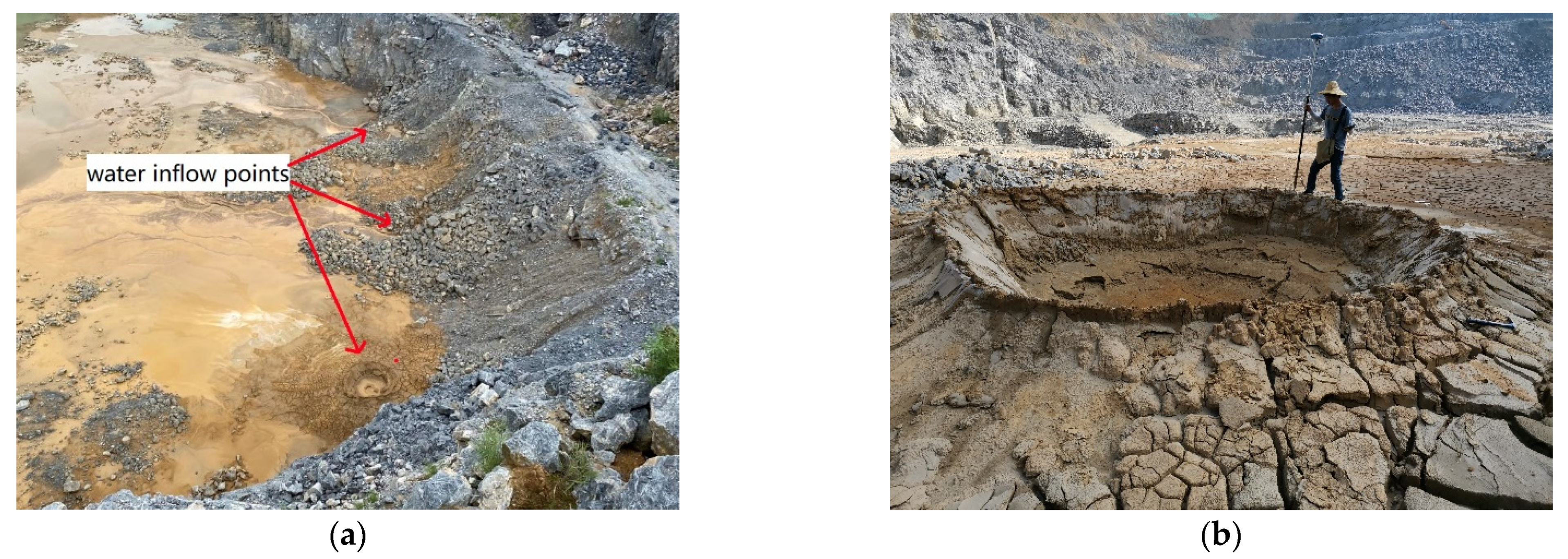
| Sequence | Number of Grouted Sections | Grouting Length (m) | Statistical Data | Elevation Distribution (m) | AUGV (m3/m) | ||||||
|---|---|---|---|---|---|---|---|---|---|---|---|
| < 60 | 60–40 | 40–20 | 20–0 | 0–−20 | −20–−40 | >−40 | |||||
| I | 61 | 1206.81 | AUGV (m3/m) | 4.91 | 3.59 | 9.24 | 11.85 | 10.38 | 9.46 | 5.11 | 8.521 |
| Grouting length (m) | 44.93 | 175.03 | 220 | 220 | 220 | 193.25 | 133.6 | ||||
| II | 56 | 940.75 | AUGV (m3/m) | 1.86 | 3.08 | 4.64 | 4.34 | 8.01 | 9.07 | 0.15 | 5.521 |
| Grouting length (m) | 28.7 | 165.9 | 180 | 180 | 180 | 172.65 | 33.5 | ||||
| Total | 117 | 2147.56 | AUGV (m3/m) | 3.72 | 3.34 | 7.17 | 8.47 | 9.31 | 9.28 | 4.12 | 7.207 |
| Grouting length (m) | 73.626 | 340.93 | 400 | 400 | 400 | 365.9 | 167.101 | ||||
| Verification Borehole | Burial Depth of Test Section (m) | q (Lu) | (Lu) | Grouting Borehole | Burial Depth of Test Section (m) | q (Lu) | (Lu) |
|---|---|---|---|---|---|---|---|
| JCK1 | 29.00–60.00 | 2.445 | 2.170 | K19 | 20.50–40.00 | 61.939 | 20.114 |
| 40.00–52.30 | 30.700 | ||||||
| 60.00–80.00 | 2.534 | 52.30–60.50 | 43.089 | ||||
| 59.00–82.00 | 11.008 | ||||||
| 80.00–100.00 | 2.303 | 82.00–110.00 | 2.770 | ||||
| 112.00–137.03 | 3.632 | ||||||
| 100.00–120.00 | 1.940 | K20 | 29.60–45.00 | 128.563 | 25.847 | ||
| 45.00–80.00 | 17.841 | ||||||
| 120.00–142.95 | 1.567 | 80.00–100.00 | 8.436 | ||||
| 100.00–138.97 | 1.383 | ||||||
| JCK2 | 32.00–60.00 | 1.717 | 1.481 | K23 | 40.00–47.20 | 17.845 | 6.980 |
| 47.20–63.00 | 21.408 | ||||||
| 60.00–80.00 | 1.905 | 63.00–71.00 | 6.262 | ||||
| 71.00–100.00 | 2.936 | ||||||
| 80.00–100.00 | 1.933 | 100.00–120.00 | 2.739 | ||||
| 120.00–140.74 | 2.238 | ||||||
| 100.00–120.00 | 1.722 | K24 | 40.00–59.00 | 19.390 | 5.175 | ||
| 59.00–76.00 | 2.757 | ||||||
| 120.00–140.74 | 0.783 | 76.00–100.00 | 4.190 | ||||
| 100.00–141.67 | 0.247 | ||||||
| JCK3 | 29.60–47.00 | 4.814 | 2.643 | K30 | 25.00–45.00 | 29.450 | 8.915 |
| 45.00–60.00 | 2.817 | ||||||
| 47.00–67.00 | 3.962 | 60.00–91.00 | 0.878 | ||||
| 90.00–120.20 | 14.309 | ||||||
| 67.00~87.00 | 2.178 | 120.00–149.77 | 0.729 | ||||
| K31 | 32.70–60.00 | 3.457 | 3.637 | ||||
| 87.00~107.00 | 2.710 | 60.00–91.00 | 1.239 | ||||
| 91.00–106.00 | 12.024 | ||||||
| 107.00~125.83 | 0.722 | 102.00–126.13 | 1.104 | ||||
Disclaimer/Publisher’s Note: The statements, opinions and data contained in all publications are solely those of the individual author(s) and contributor(s) and not of MDPI and/or the editor(s). MDPI and/or the editor(s) disclaim responsibility for any injury to people or property resulting from any ideas, methods, instructions or products referred to in the content. |
© 2023 by the authors. Licensee MDPI, Basel, Switzerland. This article is an open access article distributed under the terms and conditions of the Creative Commons Attribution (CC BY) license (https://creativecommons.org/licenses/by/4.0/).
Share and Cite
Tang, Z.; Song, L.; Jin, D.; Chen, L.; Qin, G.; Wang, Y.; Guo, L. An Engineering Case History of the Prevention and Remediation of Sinkholes Induced by Limestone Quarrying. Sustainability 2023, 15, 2808. https://doi.org/10.3390/su15032808
Tang Z, Song L, Jin D, Chen L, Qin G, Wang Y, Guo L. An Engineering Case History of the Prevention and Remediation of Sinkholes Induced by Limestone Quarrying. Sustainability. 2023; 15(3):2808. https://doi.org/10.3390/su15032808
Chicago/Turabian StyleTang, Zhen, Lei Song, Dianqi Jin, Ligen Chen, Gan Qin, Yongjun Wang, and Lei Guo. 2023. "An Engineering Case History of the Prevention and Remediation of Sinkholes Induced by Limestone Quarrying" Sustainability 15, no. 3: 2808. https://doi.org/10.3390/su15032808
APA StyleTang, Z., Song, L., Jin, D., Chen, L., Qin, G., Wang, Y., & Guo, L. (2023). An Engineering Case History of the Prevention and Remediation of Sinkholes Induced by Limestone Quarrying. Sustainability, 15(3), 2808. https://doi.org/10.3390/su15032808








